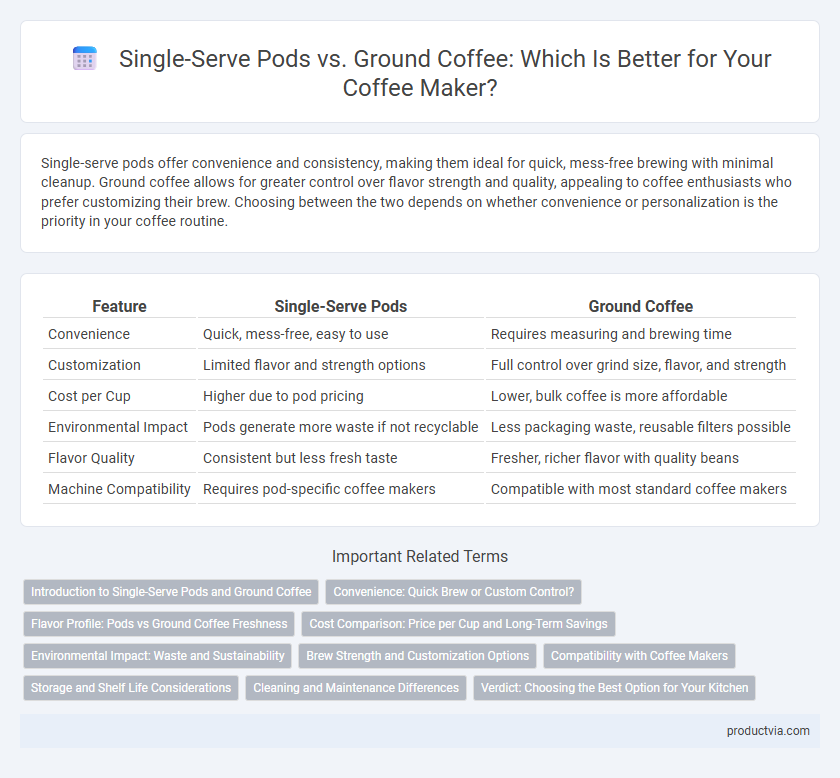Single-serve pods offer convenience and consistency, making them ideal for quick, mess-free brewing with minimal cleanup. Ground coffee allows for greater control over flavor strength and quality, appealing to coffee enthusiasts who prefer customizing their brew. Choosing between the two depends on whether convenience or personalization is the priority in your coffee routine.
Table of Comparison
| Feature | Single-Serve Pods | Ground Coffee |
|---|---|---|
| Convenience | Quick, mess-free, easy to use | Requires measuring and brewing time |
| Customization | Limited flavor and strength options | Full control over grind size, flavor, and strength |
| Cost per Cup | Higher due to pod pricing | Lower, bulk coffee is more affordable |
| Environmental Impact | Pods generate more waste if not recyclable | Less packaging waste, reusable filters possible |
| Flavor Quality | Consistent but less fresh taste | Fresher, richer flavor with quality beans |
| Machine Compatibility | Requires pod-specific coffee makers | Compatible with most standard coffee makers |
Introduction to Single-Serve Pods and Ground Coffee
Single-serve pods offer convenience and consistency with pre-measured coffee doses compatible with machines like Keurig and Nespresso. Ground coffee provides greater control over flavor, grind size, and brewing methods suitable for drip coffee makers, French press, and espresso machines. Choosing between single-serve pods and ground coffee depends on user preferences for speed, customization, and environmental impact.
Convenience: Quick Brew or Custom Control?
Single-serve pods offer unmatched convenience with quick brew times and minimal cleanup, ideal for busy mornings or office settings. Ground coffee provides greater custom control over strength, flavor, and grind size, appealing to coffee enthusiasts who prioritize taste precision. Choosing between pods and ground coffee depends on whether speed or personalized brewing experience is the priority.
Flavor Profile: Pods vs Ground Coffee Freshness
Single-serve pods offer consistent flavor due to pre-measured portions and sealed packaging that preserves freshness, but may lack the depth found in freshly ground coffee. Ground coffee provides richer, more complex flavor profiles when freshly ground, as essential oils and aromas stay intact longer before brewing. Choosing between pods and ground coffee depends on balancing convenience with the desire for optimal freshness and nuanced taste in coffee makers.
Cost Comparison: Price per Cup and Long-Term Savings
Single-serve pods typically cost between $0.30 to $0.70 per cup, whereas ground coffee averages around $0.10 to $0.50 per cup, making ground coffee more cost-effective for daily use. The initial investment for pod machines can be lower, but the ongoing expense of pods adds up substantially over time compared to bulk ground coffee purchases. Long-term savings favor ground coffee due to lower per-cup costs and greater flexibility in quantity, appealing to frequent coffee drinkers aiming to minimize expenses.
Environmental Impact: Waste and Sustainability
Single-serve pods generate significantly more waste compared to ground coffee due to their disposable plastic or aluminum containers, contributing to landfill overflow and environmental pollution. Ground coffee, when used with reusable filters, minimizes waste and supports sustainable practices by allowing composting of organic grounds. Choosing coffee makers compatible with ground coffee promotes eco-friendly consumption and reduces the carbon footprint associated with packaging and pod production.
Brew Strength and Customization Options
Single-serve pods offer consistent brew strength with pre-measured coffee doses, ensuring convenience but limited customization. Ground coffee provides the flexibility to adjust grind size, coffee quantity, and brew strength to match personal taste preferences. Choosing between pods and ground coffee depends on the user's desire for convenience versus control over flavor intensity and strength.
Compatibility with Coffee Makers
Single-serve pods offer precise compatibility with designated single-serve coffee makers, ensuring convenience and consistency in brewing. Ground coffee provides versatility, compatible with various drip, pour-over, and espresso machines but requires proper measuring and filtering. Selecting the right coffee type depends on the specific coffee maker's design and desired customization in flavor and strength.
Storage and Shelf Life Considerations
Single-serve pods offer convenient, pre-measured portions with sealed packaging that extends freshness for up to 6-12 months, minimizing exposure to air and moisture. Ground coffee requires airtight containers stored in cool, dark places to maintain quality, but typically has a shorter shelf life of about 1-2 weeks once opened due to oxidation. Proper storage of both options directly impacts flavor retention and overall brewing performance in coffee makers.
Cleaning and Maintenance Differences
Single-serve pod coffee makers require minimal cleaning, with most machines featuring removable pod holders and drip trays that are easy to rinse, reducing overall maintenance time. In contrast, ground coffee machines demand regular cleaning of brewing baskets and carafes to prevent buildup of coffee oils and residue, which can affect flavor and machine longevity. Descaling frequency remains similar for both types, but pod machines benefit from fewer grounds-related clogging issues.
Verdict: Choosing the Best Option for Your Kitchen
Single-serve pods offer convenience, consistent flavor, and minimal cleanup, making them ideal for busy households or offices. Ground coffee provides greater flexibility in flavor profiles, cost-effectiveness, and environmental benefits, appealing to enthusiasts and those seeking customized brews. The best choice depends on your priorities: ease and speed with pods, or control and variety with ground coffee.
Single-serve pods vs Ground coffee for coffee makers Infographic

 productvia.com
productvia.com